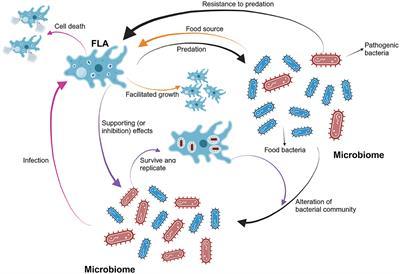Title: Unraveling Two Decades of Bacterial Evolution in a Freshwater Ecosystem
Over the past twenty years, a team of researchers has delved into the intricate world of bacterial ecology in a single freshwater lake, revealing transformative insights that could reshape our understanding of microbial life. Published in the prestigious journal Nature, this groundbreaking study highlights how these tiny organisms adapt and evolve in response to environmental changes, ultimately influencing the broader ecosystem. With the implications of their findings echoing well beyond the water’s edge, this comprehensive research not only chronicles the evolutionary journey of bacteria but also emphasizes their vital role in maintaining the health and balance of freshwater habitats. As we face pressing environmental challenges, the revelations from this extensive two-decade study could provide critical lessons on biodiversity and ecosystem resilience.
Impact of Environmental Changes on Bacterial Diversity in Freshwater Ecosystems
The changing environmental conditions in freshwater ecosystems have a profound influence on bacterial diversity. Over the past two decades, studies have shown how factors like temperature fluctuations, nutrient loading, and pollution are reshaping the microbial landscapes of lakes. This transformation is not just a matter of species loss; it also involves shifts in community structure, leading to the dominance of certain taxa over others. As a result, some previously abundant species have been displaced, while opportunistic bacteria thrive in the altered conditions, showcasing resilience and adaptability of microbial life.
Recent data indicates that specific changes, such as increased eutrophication and varying hydrological patterns, have directly correlated with shifts in bacterial groups. Researchers have noted the emergence of pathogenic species, largely attributable to nutrient surpluses, while beneficial taxa that play essential roles in nutrient cycling have significantly diminished. The following table illustrates the changes in bacterial diversity before and after a significant environmental shift:
| Bacterial Group | Before Environmental Change | After Environmental Change |
|---|---|---|
| Proteobacteria | 35% | 60% |
| Cyanobacteria | 15% | 5% |
| Firmicutes | 25% | 10% |
| Actinobacteria | 20% | 25% |
These statistics exemplify the resilience of certain microbial communities while highlighting the ecological consequences of human-induced environmental changes. With projections indicating ongoing alterations due to climate change, the continuous monitoring of bacterial diversity and its implications for ecosystem health is increasingly critical. Understanding these dynamics allows for more informed management strategies aimed at conserving freshwater ecosystems in the face of environmental stressors.
Key Insights into Microbial Adaptations Over Twenty Years
Over the past twenty years, researchers have meticulously chronicled the dynamic adaptations of microbial communities in a select freshwater lake, revealing fundamental shifts that reflect broader ecological trends. One of the most fascinating developments has been the emergence of phenotypic plasticity, allowing certain bacterial strains to alter their metabolism in response to fluctuating environmental conditions. Such flexibility has been crucial for survival, particularly during periods of nutrient scarcity or changes in water temperature. The interplay between resource availability and bacterial community composition showcases the intricate relationships that thrive beneath the surface.
In addition to phenotypic adaptations, genomic studies highlight the rapid evolution of competitive traits among dominant species. Findings suggest that horizontal gene transfer has played a pivotal role in enhancing the adaptability of these communities, enabling beneficial traits to spread swiftly across populations. This phenomenon is often coupled with changes in microbial interactions, leading to the establishment of dense biofilms that can significantly alter ecosystem dynamics. The following table outlines some of the key adaptations observed in various bacterial species over the two decades:
| Bacterial Species | Key Adaptation | Environmental Trigger |
|---|---|---|
| Species A | Increased biofilm formation | Nutrient limitation |
| Species B | Metabolic switching | Temperature fluctuation |
| Species C | Horizontal gene transfer | Environmental stresses |
Strategies for Sustaining Bacterial Resilience in Lake Ecosystems
To foster bacterial resilience within lake ecosystems, it is essential to adopt an integrative approach that combines both ecological and evolutionary strategies. Key measures include:
- Monitoring Water Quality: Regular assessments of nutrient levels, pH, and pollution can identify stressors that affect bacterial communities.
- Promoting Biodiversity: Encouraging a diverse array of bacterial species enhances ecosystem stability, allowing for redundancy and functional resilience in response to disturbances.
- Implementing Restoration Programs: Restoring natural habitats and mitigating invasive species can help maintain a balanced microbial ecosystem.
- Enhancing Connectivity: Linking fragmented habitats ensures gene flow, which can strengthen bacterial adaptability and survival.
Furthermore, understanding the evolutionary dynamics of bacteria offers insights into their resilience. Research indicates that:
- Horizontal Gene Transfer: This process plays a critical role in promoting genetic diversity and adaptability among bacterial populations.
- Selection Pressures: Identifying and mitigating stressors can reduce harmful selective pressures that lead to the loss of beneficial bacterial traits.
- Microbial Metacommunities: Recognizing the interactions between different bacterial groups can inform management strategies aimed at enhancing community resilience.
| Strategy | Expected Outcome |
|---|---|
| Monitoring Water Quality | Enhanced early detection of harmful shifts in bacterial populations |
| Promoting Biodiversity | Greater ecosystem stability through functional redundancy |
| Implementing Restoration Programs | Restoration of critical habitats and microbial niches |
| Enhancing Connectivity | Increased gene flow leading to adaptive potential |
Key Takeaways
As we reflect on two decades of pioneering research into the bacterial ecology and evolution within freshwater lakes, the findings outlined in this study illuminate the complex interplay between microorganisms and their environment. This extensive investigation not only enhances our understanding of bacterial dynamics but also raises important questions about ecosystem health and resilience in the face of climate change and human impact.
The work presented in “Nature” provides a vital framework for future studies, emphasizing the need for continued monitoring and exploration of microbial communities. As researchers delve deeper into these microscopic worlds, the implications for biodiversity conservation and water quality management become increasingly clear.
In a time when freshwater ecosystems are under unprecedented stress, the insights gained from this long-term research offer a glimmer of hope and a call to action for both scientists and policymakers alike. Continuing this line of inquiry will be essential to preserve our planet’s lakes for generations to come, ensuring they remain vibrant ecosystems teeming with life. As we close this chapter, the journey into the unseen world of bacteria is far from over—indeed, it is only just beginning.































